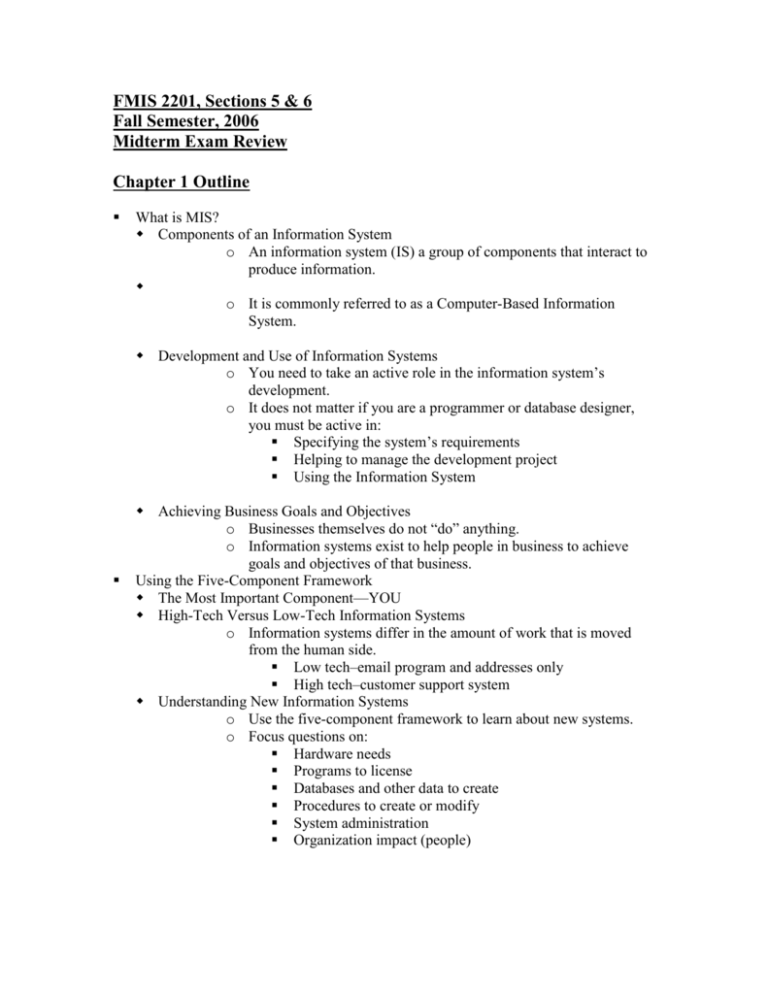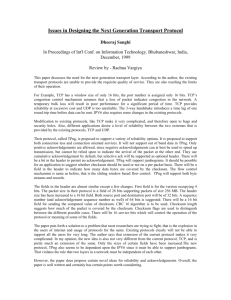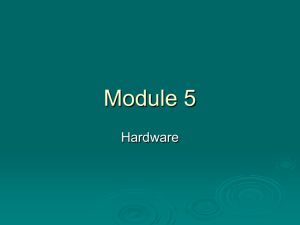Study Guide
advertisement

FMIS 2201, Sections 5 & 6 Fall Semester, 2006 Midterm Exam Review Chapter 1 Outline What is MIS? Components of an Information System o An information system (IS) a group of components that interact to produce information. o It is commonly referred to as a Computer-Based Information System. Development and Use of Information Systems o You need to take an active role in the information system’s development. o It does not matter if you are a programmer or database designer, you must be active in: Specifying the system’s requirements Helping to manage the development project Using the Information System Achieving Business Goals and Objectives o Businesses themselves do not “do” anything. o Information systems exist to help people in business to achieve goals and objectives of that business. Using the Five-Component Framework The Most Important Component—YOU High-Tech Versus Low-Tech Information Systems o Information systems differ in the amount of work that is moved from the human side. Low tech–email program and addresses only High tech–customer support system Understanding New Information Systems o Use the five-component framework to learn about new systems. o Focus questions on: Hardware needs Programs to license Databases and other data to create Procedures to create or modify System administration Organization impact (people) Components Ordered by Difficulty and Disruption o Hardware–usually simple to install o Program, database, and procedure development or modification can be difficult. Information Characteristics What Is Information? o Information is defined as: o Knowledge derived from data o Data presented in a meaningful context o Data processed by summing, ordering, averaging, grouping, comparing, or other similar operations o A difference that makes a difference Information Is Subjective Characteristics of Good Information o Accurate o Timely o Relevant o To context o To subject o Just barely sufficient o Worth Its Cost Information Technology Versus Information Systems Moore’s Law o Gordon Moore, cofounder of Intel Corporation, stated that because of technology improvements in electronic chip design and manufacturing the number of transistors per square inch on an integrated chip doubles every 18 months, and as a result the speed of computer chip, also doubles Dramatic Reduction in Price/Performance Ratio Chapter 2 Outline Information Systems for Competitive Advantage o Businesses continually seek to establish competitive advantage in the marketplace. o There are eight principles: The first three principles concern products. The second three principles concern the creation of barriers. The last two principles concern establishing alliances and reducing costs. Information Systems for Problem Solving o A Customer Relationship Management System (CRM) o Knowledge Management System (KMS) o A Manufacturing Quality-Control Information System Information Systems for Decision Making o Decision Level Decisions occur at three levels in organizations. Operational decisions concern day-to-day activities. Information systems that support operational decision making are called transaction processing systems (TPS). Managerial decisions concern the allocation and utilization of resources. Information systems that support managerial decision making are called management information systems (MIS). Strategic decision making concern broader-scope organizational issues. Information systems that support strategic decision making are called executive information systems (EIS). o The Decision Process Two decision processes (method by which a decision is to be made) are structured and unstructured. Structured decision process is one for which there is an understood and accepted method for making the decision. Unstructured process is one for which there is no agreed on decision making process. The terms structured and unstructured refers to the decision process-not the underlying subject. o The Relationship Between the Decision Type and the Decision Process Chart with Structured and Unstructured along with TPS, MIS and Strategic Levels o Different Types of Information Systems for Different Types of Decisions Automated information systems are those by which the computer hardware and program components do most of the work. Humans start the programs and use the results. Augmentation information systems are those in which humans do the bulk of the work. These systems augment, support, or supplement the work done by People (email, instant messaging, videoconferencing, etc) to aid in decision making o Information Systems and Decision Steps There are five steps Intelligence gathering Alternative formulation Choice Implementation Review Chapter 3 Outline Essential Hardware Terminology Input, Processing, Output, and Storage Hardware Representing Computer Instructions and Data o Computers represent data using binary digits, called bits. A bit is either a zero or a one. Bits are used for computer data because they are easy to represent physically. A switch can either be closed or open. Bits are grouped into 8-bit chunks called bytes Knowledge for the Informed Professional o You have two choices: You can tell the people in the IS department to specify what they think is best; Or, with a little bit of knowledge on your part, you can work with the IS department to ask intelligent questions about the relationship of these computers to the kind of work your department does CPU and Memory Usage o The central processing unit (CPU) reads instructions and data from main memory, and it writes data to main memory via a data channel, or bus. o Main memory is also called RAM memory, or just RAM. RAM stands for random access memory. The term random is used to indicate that the computer does not need to access memory cells in sequence; rather, they can be referenced in any order. Memory is used for three purposes: It holds instructions of the operating system It holds instructions for application programs such as Excel or Acrobat. It holds data. Work at the CPU o The term volatile is used to indicate that data will be lost when the computer is not powered. Main memory is volatile. Magnetic and optical disk are nonvolatile. Factors that Affect Computer Performance The CPU and Memory o The CPU reads instructions and data from memory via the data bus. o The maximum speed at which it transfers data is determined by the speed of main memory and the speed and width of the data bus. A bus that is 16 bits wide can carry 16 bits at a time; one that is 64 bits wide can carry 64 bits at a time. o Each CPU has a clock speed that is measured in cycles per second, or hertz. In general, the faster the clock speed, the faster work will get done. Main Memory o Normally, a particular computer make and model is designed to use a given memory type, and the speed for that type is fixed. There is nothing you can do to increase memory speed. o o You can, however, increase the amount of main memory, up to the maximum size of memory that your computer brand and model can hold. Magnetic Disks o Data are recorded on magnetic disks in concentric circles. The disks spin inside the disk unit, and as they spin magnetic spots on the disks are read or written by the read/write head. Optical Disks o There are two kinds of optical disks: CDs (compact disks) and DVD (digital versatile disks). Video Displays o There are two types of video display monitors: CRTs and LCDs. A Survey of Software Operating Systems Application Software o Application software consists of programs that perform a business function. ome application programs are general purpose, such as Excel or Word. Other application programs are specific QuickBooks, for example, is an application program that provides general ledger, and other accounting functions. o Horizontal-Market Applications Software Horizontal-market application software provides capabilities common across all organizations and industries. o Vertical-Market Applications Software Vertical-market application software serves the needs of a specific industry. Firmware o Firmware is computer software that is installed into devices like printers, print servers, and various types of communication devices. The software is coded just like other software, but it is installed into special, read-only memory of the printer or other device. Chapter 4 Outline Purpose of a Database o The purpose of a database is to keep track of things that involve more than one theme. What Is a Database? o A database is a self-describing collection of integrated records. o Relationships Among Records o Columns or fields, in turn, are grouped into rows, which are also called records Metadata o A database is a collection of tables plus relationships among the rows in those tables, plus special data, called metadata. o Metadata describes the structure of the database. A key is a column or group of columns that identifies a unique row in a table Components of a Database Application System The Database Management System o A database management system (DBMS) is a program used to create, process, and administer a database. o Almost no organization develops its own DBMS. o Applications use the DBMS for four operations: read, insert, modify, or delete data. Database Applications o A database application is a collection of forms, reports, queries, and application programs that process a database. Enterprise DBMS Versus Personal DBMS o Enterprise DBMS These products process large organizational and workgroup databases. o Personal DBMS These products are designed for smaller, simpler database applications. Developing a Database Application System o The reason that user involvement is so important for database development is that the database design depends entirely on how users view their business environment. The Entity-Relationship Data Model o Entities have relationships to each other. If two entities have a plain straight line between them, then this type of relationship is called one-to-one. If two entities have a line between them, but at the end of one line in one of the two directions (left or right) exists an arrow (crow’s foot), then this type of relationship is called one-to-many. Database Design o Database design is the process of converting a data model into tables, relationships, and data constraints. o Normalization is the process of converting poorly structured tables into two or more well-structured tables. Importance of Users’ Review o Users are the final judges as to what data the database should contain and how records in the database should be related to one another. o The easiest time to change the database structure is during the data modeling stage Chapter 5 Outline Fundamental Networking Concepts o A computer network is a collection of computers that communicate with one another over transmission lines. o Three basic types of networks are: Local area networks (LANs)–connects computers that reside in a single geographic location on the premises of the company that operates the LAN. Wide area networks (WANs)–connects computers at different geographic sites. Internets–a network of networks Layered Protocols Communications Protocols o A protocol is a standard means for coordinating an activity between two or more entities. o A communications protocol is a means for coordinating activity between two or more communicating computers. The TCP/IP-OSI Architecture o The International Organization for Standardization (ISO) developed the Reference Model for Open Systems Interconnection (OSI), an architecture that has seven layers. o The Internet Engineering Task Force (IETP), developed a fourlayer scheme called the TCP/IP (Transmission Control Program Internet Protocol) architecture. o The most commonly used architecture today is a five-layer blend of these two architectures called the TCP/IP-OSI architecture. o Layer 5 Layer 5 generates and receives email (and attachments like photos) according to one of the standard email protocols generated for layer 5 Most likely its Simple Mail Transfer (SMTP) Hypertext Transfer Protocol (HTTP) is used for the processing of Web pages. The Internet is the communications structure that supports all application-layer protocols, including HTTP, SMTP, and other protocols. o Layer 4 TCP places identifying data in front of each segment that are akin to the To and From addresses that you would put on a letter for the postal mail. o Layer 3 For the TCP/IP architecture, the layer-3 protocol is the Internet Protocol (IP). The chief purpose of IP is to route messages across an internet. o Layers 1 and 2 Basic computer connectivity is accomplished using Layers 1 and 2 of the TCP/IP-OSI architecture. Computing devices called switches facilitate data communication. Local Area Networks o A local area network (LAN) is a group of computers connected together on a single company site. o The IEEE 802.3, or Ethernet, Protocol o IEE 802.3 or Ethernet Protocol (Continued) o Most personal computers today are equipped with an onboard NIC that supports what is called 10/100/1000 Ethernet. o These products conform to the 802.3 specification and allow for transmission at a rate of 10, 100, or 1,000 Mbps. o Communications speeds are expressed in bits, whereas memory sizes are expressed in bytes. LANs with Wireless Connections o Several different wireless standard exist o As of 2005, the most popular is IEEE 802.11g o The current standard, 802.11g allows speeds of up to 54 Mbps. Wide Area Networks Connecting the Personal Computer to an ISP: Modems Networks of Leased Lines Public Switched Data Network Virtual Private Network Criteria for Comparing Network Alternatives How the Internet Works Domain Name System o The last letter in any domain name is referred to as the top-leveldomain (TLD). o In the domain www.icann.org the top level domain is .org o URLs begin with a domain and then are followed by optional data that locates a document with that domain. o Thus, in the URL www.prenhall.com/kroenke , the domain name is www.prenhall.com , and /kroenke is a directory within that domain.







